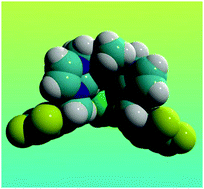Chloride-binding in organic–water mixtures: the powerful synergy of C–H donor groups within a bowl-shaped cavity†
Abstract
For the first time, the tetrafluorobenzyl unit has been considered as a C–H⋯anion binding motif. In synergy with imidazolium groups within a bowl-shaped receptor, it has allowed for the effective binding of chloride in solution. Remarkable affinity was observed in organic–water mixtures.



 Please wait while we load your content...
Please wait while we load your content...